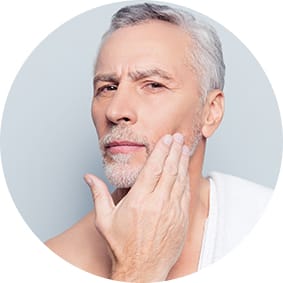- What Is a Facelift?
- Facelift Before-and-After Photos
- Facelift Candidates
- Facelift Procedure
- Types of Facelift Surgery
- Facelift Recovery
- Facelift Results
- Facelift Scars
- Facelift and Neck Lift
- Combining Surgeries
- Mini Facelift
- Facelift Cost
- What Makes a Beautiful Face?
Warning: Invalid argument supplied for foreach() in /var/www/vhosts/drmele.com/httpdocs/wp-content/themes/rm-theme/inc/partials/anchors.php on line 24
Factors such as aging, sun exposure, and smoking can cause facial wrinkling, sagging, and loss of elasticity. For many, such damage can result in an outward appearance that does not match how we feel inside. Using his skill and artistry, Joseph A. Mele, MD, FACS is a San Francisco Bay Area plastic surgeon who can improve the signs of aging and provide you with natural-looking results. At his practice, facelift patients anticipate beautiful outcomes and a rewarding experience.
What Is a Facelift (Rhytidectomy)?
A facelift is a surgical procedure that removes loose skin from the face and the neck. While a neck lift puts the emphasis on tightening the neck, it still tightens the lower face. A facelift, on the other hand, always includes tightening the neck. Since the neck often ages faster than the face, tightening the neck maintains facial harmony.
Anatomically, the face spans from the eyes down to the neck. We all learn that the face starts at the hairline and extends to the neck, but the surgical face is defined by the area covering the facial bones. The bones of the forehead are skull bones, not facial bones, and therefore are not part of the face. Lifting the forehead is called a brow lift. Brow lifts can be done independently or as part of facial rejuvenation surgery. Since the face and brow may age differently, it makes sense to evaluate each region independently for rejuvenation.
Many patients choose to include eyelid surgery as part of their facial rejuvenation procedure. Like a brow lift, the eyelids can be addressed separately, or in conjunction with a facelift as part of a single operation with one recovery period. While an eyelid lift, or blepharoplasty, is not considered part of the facelift, it is often added in order to create a balanced rejuvenation and facial harmony.
The face ages because our skin loosens and sags, and a facelift is designed to reverse this process. There is another component to facial aging, however, that facelifts do not address. As we age, our faces lose volume. During your consultation, recommendations may be made for volume restoration. This can include fat grafting, dermal grafting, or even facial implants. Pictures from your youth can be helpful for determining where volume has been lost.
So a facelift lifts what most consider the lower face and neck. Facelifts reduce aging wrinkles and improve skin tone by tightening the skin. The result is a rejuvenated, more youthful appearance. Our facelift patients are amazed when they see what can be accomplished at the hands of an exceptional cosmetic plastic surgeon.
Facelift - Before and After Pictures














Here are some things to look for as you compare the before-and-after facelift images above:
Before the facelift the appearance is TIRED:
- The cheeks are flattened
- Indistinct definition between the face, neck and chin
- Relaxed mid-face (longer lower eyelid and sagging cheeks)
- Elongated nasolabial folds and marionette lines (extending from nose to chin)
- Detached and droopy neck skin
After the facelift the face looks RESTED:
- Reduced Nasolabial Folds and Marionette Lines
- Elevation of the cheek
- Sub-mental definition restored (the angle between the neck and chin)
- Tightening of the loose neck skin (“turkey neck”)
- Enhanced definition of the jawline
- Definition of the border between the face and neck is restored
Am I a Candidate for Facelift Surgery?
Good candidates for facial rejuvenation are men or women with visible signs of aging, which can be improved with a facelift. Good health and realistic expectations are equally important. A facelift will not stop the aging process, but it can push back the years.
Medical issues can affect the results of your facelift, so tell your doctor about all medical conditions and any medications you take. Pre-existing medical conditions should be well controlled before having any elective surgery. These topics will be discussed during your consultation appointment to determine if you are ready for a facelift.
Recovery time is also an important consideration when planning your facial rejuvenation surgery. You should plan your surgery when you have enough time to recover before returning to your normal daily activities. Facelifts usually are not painful, so the recovery is more about healing than about rehabbing. Adequate time for swelling and bruising to subside will allow you to feel more comfortable in public, and more confident with your results. More about facelift recovery is described below.
Most plastic surgeons recommend smoking cessation prior to a facelift. A minimum of four weeks without smoking before and after the surgery is required. In addition, smoking cessation will also slow the aging of your face and has numerous other health benefits. It may be old news, but smoking is still bad for your health and your face.
How is the Facelift Procedure Performed?
The facelift can be accomplished using a variety of techniques. The specific facelift method is not as important as the craft with which it is applied. Most techniques share many aspects, and there is a large amount of overlap.
In general, an incision can be made along the hairline or around the ears. Once the incision is made, Dr. Mele will remove excess fat and skin, reposition the remaining skin, and close the incision. In most cases, facelift surgery is performed under general anesthesia on an outpatient basis, though Dr. Mele prefers to keep his facelift patients overnight for their safety and comfort.
Beware of surgeons using “brand name” facelifts. There are several options in facelift techniques, but the number of options is small, and the best ones are not new. They have been described for many years. The main variations in facelift techniques are explained in the next section.
Rhytidectomy (Facelift) Presentation
Facelift procedures can reduce those aging wrinkles, tone and tighten the skin, and produce a rejuvenated, more youthful appearance. Our face lift patients throughout the San Francisco Bay Area are amazed when they see what can be accomplished at the hands of an exceptional cosmetic surgeon.
What Are the Different Types of Facelifts?
Skin Only Facelifts
Skin Only Facelifts are exactly what they sound like. The facial skin, and the thin layer of subcutaneous fat that contains the skin’s blood supply and nerves, is lifted. All skin only facelift techniques involve these steps:
- Releasing the facial skin
- Elevating the skin upward and backward on the face
- Removing the excess skin caused by the lifting
- Carefully closing the incision
So that the skin moves smoothly, attachments between the skin and deeper structures along the sides of the face and neck are released. The amount of release is determined by the depth and location of the facial wrinkles. The latin word for wrinkles is rhytids, so the facelift is also called a Rhytidectomy, or wrinkle-removing procedure. The deeper structures are not specifically moved during skin only facelifts, though the cheek fat pads can be raised along with skin if they are low.
The benefits of a skin only facelift are: less swelling and a faster recovery. The limitation is that the deeper muscle layers of the cheek and neck are not tightened, so good candidates for a skin only facelift are patients who do not need tightening of the deeper structures. Most “redo” facelifts are “skin only”; however, the primary facelift leaves a thin sheet of scar beneath the skin. This scar layer can often be released and used like the SMAS layer for additional support, and perhaps longevity, as discussed next.

SMAS Facelifts
SMAS Facelifts take the elements of a facelift one layer deeper. The acronym SMAS is the name of the layer that lies beneath the skin and subcutaneous fat. SMAS stands for Superficial Musculo-Aponeurotic System, and now you know why we say SMAS. On the neck, the layer continues as the platysma muscle. Above the jaw, the layer usually has no muscle fibers. It is a tough facial layer that continues up to the cheek bones, where it is well attached. Lifting the SMAS can provide additional lifting of the aging face, without additional tension on the skin. For prominent jowls and neck bands, the SMAS techniques may provide additional correction and longevity of the facelift results. The downside to SMAS techniques is additional and more prolonged swelling, so a longer recovery is expected.
A variation of the skin only lift involves SMAS Plication. This technique does not elevate the SMAS, but tightens it by folding the SMAS in on itself, and suturing it in place. This tightens the SMAS directly, and sometimes is a good compromise when a full SMAS lift is more than is needed, but the skin only lift needs a boost.

Dual Plane Facelifts
Dual Plane Facelifts are a type of SMAS facelift. As the name implies, two layers are used. The superficial layer is the same as the skin only lift, while the deep layer is the SMAS. The advantage of elevating these two layers separately is that they can be moved in different directions. Most commonly, the deep layer is brought up vertically on the face, to reduce jowling and support the neck. The excess SMAS can be excised, or folded on itself to add volume to the cheek. The SMAS vector may be oriented more horizontally on the sides of the neck, as needed. The skin layer is usually brought up in the direction of the skin only lift, parallel to the jaw line. The skin excess can be removed with a scar hidden around the ear and with the least distortion of the hairline.

Deep Plane or Composite Facelifts
Deep Plane or Composite Facelifts are also SMAS lifts. Instead of separating the skin and the SMAS, the two are elevated together as a composite flap. The advantage is a simpler disection. The disadvantage is that the two layers move together in the same direction. Having different directions of tightening in each layer cannot be done with the deep plane facelift, as it can with the dual plane techniques. If during the procedure, it become clear that different directions of pull are necessary, the composite facelift can be converted into a dual plane facelift.

Subperiosteal Facelifts
Subperiosteal Facelifts are the deepest level of lift possible on the face. The technique involves elevating all the soft tissue at the level of the bone. All the facelift techniques listed above are superficial to the muscles that provide expression and motion to the face. The subperiosteal technique moves the muscles of expression, the SMAS and the skin as a single unit. Subperiosteal techniques are most often used in conjunction with endoscopic facial plastic surgery. The advantage is that this layer is easier to dissect with an endoscope. The main disadvantages are a significantly decreased ability to reduce the superficial wrinkles, and more swelling than the SMAS techniques. Because of this, the subperiosteal facelift is the approach least often used.

Liquid Facelift
Liquid Facelifts are not facelifts at all, but are included here for completeness, and because they offer some advantages over facelifts for specific, more superficial problems. Liquid facelifts are essentially fillers, which are used to add volume to the face. When the face develops deep lines around the nose and mouth, filler can be used to reduce their appearance. This can be done independently from facelifts, or in conjunction with a facelift. Fillers provide much more temporary results than a facelift, so the advantages and disadvantages must be evaluated on an individual basis. Dermal Grafts may provide a longer lasting option, especially when performed in conjunction with a facelift. More about Fillers can be found here: Facial Wrinkle Reduction with Dermal Fillers.

What Can I Expect During Facelift Recovery?
As mentioned above, facelifts are not usually painful. You should be functional in a few days, but you may not feel presentable for face-to-face interactions. Your face may feel tight, especially around the ears, but the discomfort should be tolerable. Narcotic medications are seldom needed for most patients. Many manage well with cool packs and acetaminophen.
You should expect your face to be swollen. Bruising along the lower face and neck is also common. It may take a few days to weeks for this to diminish. Keeping the head elevated and applying cool compresses immediately after surgery are helpful. You should avoid bending, straining and stooping with the face down, as this increases both swelling and the risk of bleeding.
Recovery also varies with the type of facelift. Liquid facelifts require a few days. Mini facelifts a week. Full facelifts two to three weeks. Individual results will vary, but in general, the more work done, the longer the expected recovery. Regardless of the recovery time, the procedure needs to be matched with the desired results, not the desired downtime.
How Long Will the Results of a Facelift Last?
The longevity of a facelift depends on the nature of the face being lifted. The better your skin tone, the longer your results will last. Thin skin, sun-damaged skin, and poor elasticity will decrease the longevity of the results.
Your tolerance for wrinkles also comes into play. If you are having a facelift in your thirties or forties, you are much more likely to want a secondary rhytidectomy. On the other hand, if you are having a facelift in your sixties or seventies, it is more likely that you will not need another.
Facelift surgeries peak in the fifth decade of life. A general estimate is that you will look ten years younger and that it should last for ten years. This does not mean that aging stops after a facelift. You will continue to age. You can help yourself by staying healthy, avoiding excess sun exposure, using proper moisturizers, and by not smoking or vaping.
Will the Scars from Facelift Surgery Be Noticeable?
The incisions for a facelift follow facial contours in order to remain as hidden as possible. The scars follow the contours of the ear. In front of the ear the scars tend to heal better, with thinner, smoother results. The scar can be placed in the fold in front of the ear, or follow the curves and go behind the tragus, the flap in front of the ear hole.
Behind the ear they can be more noticeable, so they are kept in the fold behind the ear and as short as possible along the lower hairline. Some patients heal vigorously with more noticeable scars, so there can be no guarantees, but meticulous surgical technique and post-operative wound care are important in achieving optimal results.
Does a Facelift Always Include a Neck Lift?
The short answer is yes. The face and neck age together, so they often need to be rejuvenated together. Each area is evaluated independently, and the amount of lifting each area needs is determined by the amount of correction desired. If the neck is smooth and clean, minimal neck lifting is needed, but even rejuvenating the jawline will provide some neck correction.
In general, a “facelift” is usually planned to lift both the face and the neck. Like a facelift, the neck lift can be a skin lift or incorporate deeper layers. When the skin of the neck is loose, it is tightened with a skin lift. When neck bands are present, these deeper structures are repaired independently.
Neck bands, also known as platysmal bands, are formed by folds in the muscle. Sometimes the folds are the edges of a separated muscle, and sometimes they are folds within the muscle. To reduce the appearance of the neck bands, a small incision is made under the chin to repair and tighten the neck muscles.
The main muscle tightened in the neck is named the platysma, so the procedure is called a platysmaplasty. A platysmaplasty forms an internal corset in the anterior neck, which supports the deeper structures, and removes tension from the skin to give a smooth, natural, and longer-lasting result.
Combining Other Facial Surgery with Facelifts
Maintaining facial harmony is paramount in maintaining beautiful results. If the primary areas of concern are the lower face and neck, a Facelift/Necklift alone can provide meaningful improvement. However, if the upper eyelids are drooping, a Facelift, by relieving the distraction of the lower face and neck, unbalances facial harmony. This can make the aging upper eyelid more apparent, detracting from the overall facial improvement.
The most frequently combined facial cosmetic surgery procedures are:
- Eyelid lift (Blepharoplasty) – to remove excess upper eyelid skin and lower eyelid bags
- Endoscopic Brow lift or Open Browlift – to elevate the brow, reduce frown lines and transverse forehead wrinkles
- Dermal grafting – to reduce the nasolabial folds and marionette lines, or augment the lips
- Chemical peel – for the lines around the mouth
- Nasal reshaping surgery (Rhinoplasty) Nose Job – to smooth a dorsal hump, improve the profile or thin a wide nose
- Facial augmentation – Chin Augmentation, Cheek Augmentation or Lip Augmentation
Mini Facelift (Mini Rhytidectomy) vs. Full Facelift
Every face is different, and individual needs will vary. For less dramatic changes, a mini facelift will be sufficient. For others, a full facelift is the only option for getting the expected results. Mini facelifts are not full facelifts, so the benefits of a shorter scar and shorter recovery are balanced by less dramatic results and a shorter duration of results.
For more information, please visit our page on Mini Facelift.
How Much Does a Facelift Cost?
If you’ve read the rest of this page, you know that there are many variations in facelifts and that sometimes eyelid lifts, grafts, or implants are used in conjunction with the rhytidectomy. At your consultation appointment all options are considered, and a precise estimate is given. Cost estimates include the surgeon and anesthesiologists’ fees plus the surgery center and overnight stay costs.
Financing options will also be discussed. More information on financing can be found on our Plastic Surgery Financing page.
What Makes a Beautiful Face?
What makes a person beautiful to you? Is it the person’s physical features such as the eyes or smile? Or does it have to do more with his or her personality? One researcher took on the challenge of figuring out just what makes a person beautiful, the results of which were published in the Journal of Personality and Social Psychology.
In this study, male participants were asked to look at photographs of females and judge their attractiveness using a six-point scale varying from extremely attractive to extremely unattractive. The results revealed specific features acquired higher attractive ratings among the subjects.
The Attractive Female Face
Features that correlate with an “Attractive Feminine Face” include:
- Large eyes
- Small nose
- Small chin
- Prominent cheekbones
- Narrow cheeks
- High eyebrows
- Large smile
The Attractive Male Face
Features that enhance an “Attractive Masculine Face” include:
- Prominent cheekbones
- Large chin
- Large smile
When it comes to making you look beautiful, plastic surgeons provide an educated eye and a wealth of experience to help you every step of the way.
Schedule a Facelift Procedure
Dr. Mele is board certified by the American Board of Plastic Surgery (ABPS) and the American Board of Surgery (ABS). He is also a member of the American Society for Aesthetic Plastic Surgery (ASAPS) and the American Society of Plastic Surgeons (ASPS). Dr. Mele has published articles on cosmetic and reconstructive plastic surgery and has presented his research at national, state, and local plastic surgery conferences. If you are interested in cosmetic surgery, our Walnut Creek and San Francisco Bay Area facelift surgeon can help you achieve pleasing results while providing you with excellent patient care.
If you are interested in facelift surgery, please contact Dr. Mele by calling (925) 943-6353. You may also ask a question by filling out our contact form.